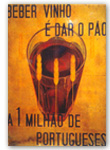1900-1907 
In 1900, Cincinnato da Costa published “
Le Portugal Vinicole”, a work presented at Paris Universal Exhibition. It talked about Portuguese wine culture: types of wines, suggestions for dividing wine regions and the best grape varieties for each region. It also suggested ways of fighting the wine crisis.
It was in 1907, under the dictatorship of João Franco, that the wine sector started being regulated. The boundaries of the demarcated region of Port and Douro wine were redefined and other wine producing regions were demarcated: Madeira, Moscatel de Setúbal, Carcavelos, Dão, Colares and Vinho Verde.
1926-1974The Estado Novo was a corporative regime that created several organisations to regulate agricultural production. One of them was the
Federação dos Vinicultores do Centro e Sul (free translation: Centre and Southern Winemakers Federation), whose main purpose was to regulate the wine production market.

Despite this, the regime launched a campaign to prohibit the growing of vines and encourage the growing of wheat. This campaign lasted from 1929 to 1937, time by which people realised this wasn’t a profitable activity. Alentejo was the region that suffered the most from this campaign, since many vines were destroyed.
The
Junta Nacional do Vinho (free translation: National Wine Committee) was created in 1937. This organisation promoted wine consumption in the country, controlled the offer, stabilised prices and stored production surpluses. The 50’s and 60’s saw the birth of cooperative wineries with modern winemaking facilities. Only cooperative wineries were allowed to buy grapes from producers, so private companies would buy the wine already made, which lead to a decrease in quality.